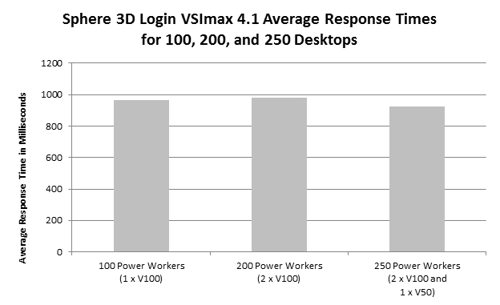Sphere 3D: V3 Hyper-Converged Appliance Shows Linear Scalability and Desktop Workload Performance
Test results of virtual desktop workloads running appliance
This is a Press Release edited by StorageNewsletter.com on March 27, 2015 at 2:36 pmSphere 3D Corporation announced test results of virtual desktop workloads running on its V3 hyper-converged appliances.
Utilizing Login VSI software, V3 appliances demonstrated performance of virtualized desktop workloads, compared to publicly-released performance reports from other hyper-converged and traditional solutions providers. Login VSI is an industry standard load testing solution for centralized virtualized desktop environments. Sphere 3D has published a new tech brief that describes How the V3 Hyper-converged Appliance Delivers Industry-Leading Performance for the Best Desktop Experience (registration required).
The company used Login VSI v4.1 workloads to measure the response times of 100 simulated desktop users performing various workloads, including the demanding workloads typical of ‘power workers’ such as those that use many graphics-intensive applications. Sphere 3D’s results showed consistent sub-second response times across all workloads.
In addition to testing single V3 appliances, Sphere 3D demonstrated the linear performance scaling and benefits of its distributed hyper-converged architecture. As their virtual desktop requirements grow and scale, the V3 distributed architecture allows customers to add a V3 appliance, of any size, without sacrificing consistent performance. For example, to simulate the performance of 250 power users’ desktop workloads, two V3 V100 appliances and a V3 V50 appliance were used. The testing concluded that V3 appliances maintain the same sub-second average response times for all 250 users, regardless of the appliance they were running on. Published test results from competing hyper-converged or traditional solutions built on clustered files systems showed degradation while scaling and a slowdown in average response times as the number of desktops increased. In comparison, V3 customers will continue to get the same consistent response time, whether adding 50 virtual desktops or a few thousand.
“Virtualizing physical desktops offers tremendous OPEX and CAPEX savings, however the lack of consistent performance and the complexity of traditional solutions has hindered the adoption of VDI by IT administrators,” said Nilesh Patel, VP, product management and marketing, Sphere3D. “With guaranteed consistent performance and drop-in appliance simplicity, customers using V3 hyper-converged appliances have shaved off months from their VDI projects while enjoying substantial TCO savings and a compelling ROI. Login VSI provided us an objective way to measure performance and compare our results against a variety of other competing solutions. Our test results demonstrate what our customers consistently tell us — V3 delivers the best end user experience.“
With its distributed hyper-converged architecture, V3 can be deployed closer to the end user and offers the lowest latency by executing workloads local to the end user’s IT infrastructure. The appliances are designed to simply drop-in and integrate into a customer’s existing IT environment to avoid unnecessary ‘rip and replacement’ of their infrastructure equipment. Regardless of the number of virtual desktops, or locations of appliances, V3 enables centralized pool management across the distributed infrastructure.
All appliances integrate compute, storage and network interface, as well as the required hypervisor infrastructure, and are managed by company’s Desktop Cloud Orchestrator (DCO) management software. It simplifies set-up, maintenance and failover of desktop pools, making it possible for desktop administrators to remain in control of their desktops and manage infrastructures locally or in remote locations, all without specialized virtualization certifications. DCO’s software architecture enables V3 appliances to be a single turnkey workload-optimized solution that delivers HA failover architecture, eliminates performance bottlenecks and installation problems, and provides predictable cost for various workloads.














 Subscribe to our free daily newsletter
Subscribe to our free daily newsletter
